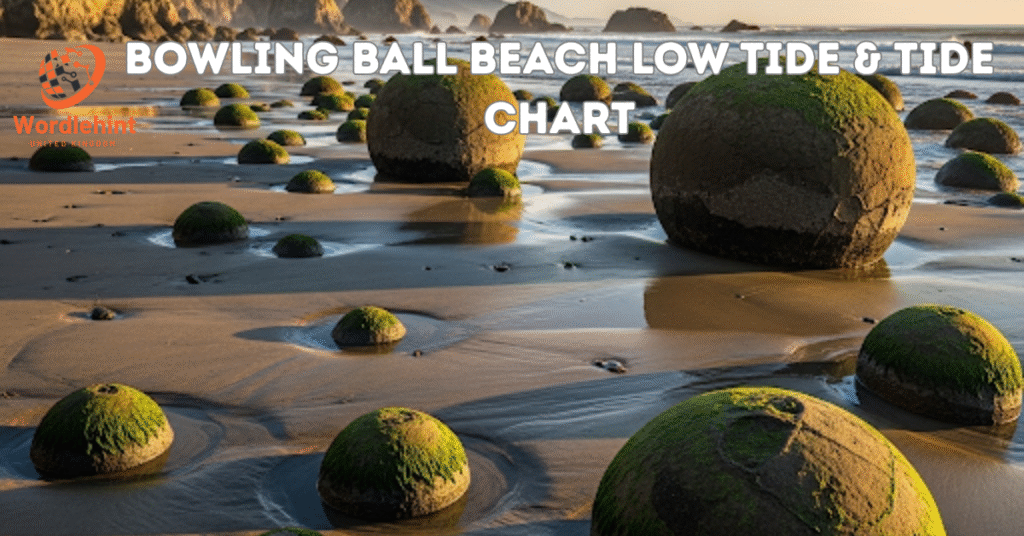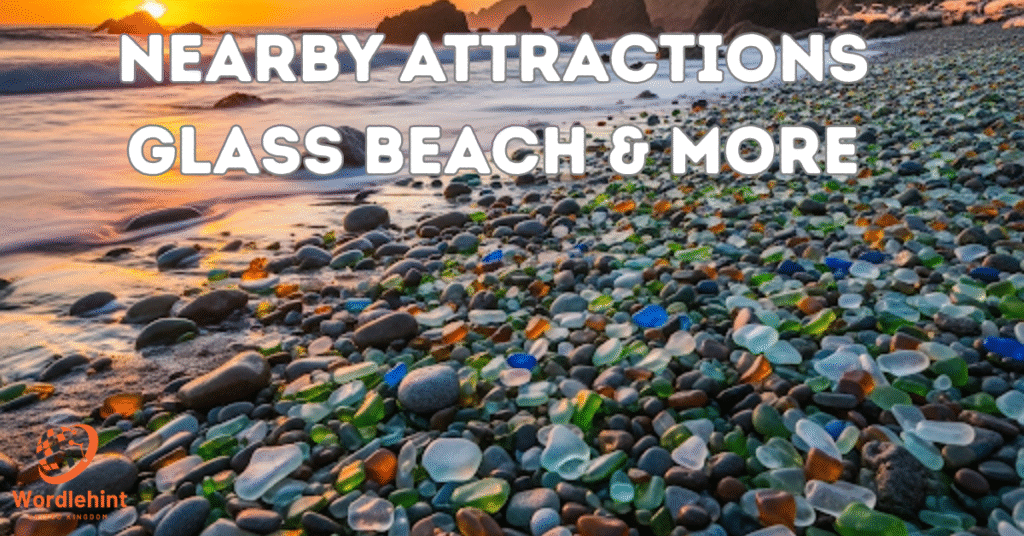Blog
How to Visit Yukevalo Island? A Complete Travel Guide 2025

Do you want to make a quiet island with white sand beaches and clear waters of the Low Coast, as well as a depth of culture, part of your vacation? Yukevalo Island is waiting for your visit.
It is your choice whether you want to go there as a solo traveler or with your family, or for a vacation. This island helps you fulfill all your needs. If it comes to a travel guide, we can cover it.
Where is Yukevalo Island located, and how can to reach this place? The best time to visit is here. In addition, it is important to estimate the necessary things used in the trip.
1. How to Reach Yukevalo Island
Step 1: International Flights
The first and best hub is that you can fly through Rivertown International Airport, which can take you to Yukevalo in a very short time. It also serves as a central gateway for international flights.
As an airport, it has now become a central entry hub that connects to other cities in the world, such as Tokyo, Sydney, and London.
It is also connected to Los Angeles. This airport has modern facilities, and we have access to duty-free shops and transport services here.
It serves as an alternative to Pacific City International Airport, which is smaller in size and has fewer international flights, so it is best for those who are regional travelers or who want to get cheap flights.
Step 2: Island Transfers
When you use the RIA or PCI to get to the island and then disembark, you have two options to get to Yukevalo Island:
- Seaplane: The fastest and most scenic way to get to the island is by boat, which takes you over turquoise lagoons and coral reefs and takes 30 to 45 minutes. It is ideal for those who want a luxurious and time-saving transfer.
- Ferry: A cheaper option is to travel via the Upriver Town Port, which takes about four hours. Ferries run regularly and offer both economy and premium seating options.
Tip: Book your transfer in advance through your hotel or someone who is affiliated with a trusted travel agency.
2. Accommodation Options on Yukevalo Island
No matter how you visit it, whether on a tight budget or in luxury, the island offers a variety of accommodations.
Budget-Friendly Options
- Talu Backpackers: It is known for its communal atmosphere, with hostels, beach hammocks, and free breakfast and group bonfires delivered to the lodge.
- Green Roots Hostel: The eco-certified hostel, powered by solar energy, is perfect for travelers who want to be environmentally conscious.
Where to Stay on Yukevalo Island
Whether you’re a budget traveler or luxury seeker, Yukevalo Island has something for everyone:
- Luxury: Ocean Pearl Resort – private villas, spa, and beachside dining.
- Mid-Range: Island Breeze Inn – cozy rooms with great views.
- Budget-Friendly: Seaside Backpackers – affordable and centrally located.
Luxury Resorts
- Azure Bay Resort & Spa: These resorts feature a variety of spa services, including overwater bungalows and infinity pools.
- The Coral Pearl Retreat: It includes a private beach with personal butler services and a sunset yacht dinner.
3. Things to Do on Yukevalo Island
There’s never a dull moment on the island:
- Snorkeling & Scuba Diving: Discover coral reefs and marine life.
- Hiking Trails: Explore lush hills and hidden viewpoints.
- Boat Tours: Island-hop and witness stunning sunsets.
- Cultural Village Visit: Experience the traditions and crafts of local communities.
Relax on the Beach
This beach, Crescent Bay and Sunrise Cove, is a great place for sunbathing, walking along the beach, and taking in the ocean views. You should bring a good book here and sit comfortably under the palm trees on the beach and read your book.
Snorkeling and Diving
To witness the vibrant marine life and its amazing coral, you can visit Coral Cove and Mermaid’s Lagoon and enjoy guided experiences. The island offers opportunities for all levels.
Hiking Adventures
If you want to see the breathtaking view of this island, you can wake up at dawn and see the breathtaking view of this island, which you will see at the peak of sunrise. Apart from that, if you are fond of seeing exotic birds and rare plants, then the rainforest paths are there for that.
Cultural Experiences
If you are interested in cooking the local cuisine, you can join cooking classes, learn island dancing, or even try your hand at basket making. The island’s Heritage Museum is available for you to gain insight into the traditions of the place.
Water Sports
If you are looking for an adventure, you can visit the resorts for jet skiing, paddle boarding, or parasailing. There are services for renting out the resort’s space, and guided tours are also offered.
Wildlife Watching
You can spot marine animals like dolphins, sea turtles, and migrating birds here. These eco-tour operators can provide respectful and informative wildlife tours to the locals.
4. Local Cuisine & Dining Spots
Indulge in authentic island flavors:
- Must-Try Dishes: Grilled reef fish, coconut rice, mango curry.
- Top Spots:
- Bay Breeze Café
- Tiki Flame Grill
- Island Roots Kitchen (vegetarian friendly)
5. Best Time to Visit Yukevalo Island
Ukiah Island experiences a tropical climate with two main types of seasons:
- Dry Season (May–October): This trip can be done between May and October, during which you can enjoy the beach in a sunny and calm environment, and it is a great place for diving and hiking.
- Wet Season (November–April): The tour runs from November to April, and during this season, you can expect occasional rain and fewer crowds. Water activities are limited, but hotel prices are reduced, making it a good choice for budget travelers.
6. Travel Essentials and Packing Tips
Required Documents
- Valid passport (6+ months validity)
- Tourist visa (check your local embassy)
- Proof of return or onward travel
- Travel insurance (recommended)
What to Pack
- Lightweight clothes and swimwear
- Comfortable walking shoes
- Sunblock and insect repellent
- Reusable water bottle
- Waterproof bag for gadgets
- Light jacket or poncho for rainy days
7. Budget Travel Tips
- Book during the shoulder seasons (April and November) for discounted rates.
- Choose local ferries over private boats for affordable transfers.
- Dine at local beach shacks for authentic, budget-friendly meals.
- Look for package deals from eco-resorts or hostels.
8. Sustainable Travel on Yukevalo Island
Protect the island’s delicate ecosystem by following eco-friendly practices:
- Avoid single-use plastics
- Don’t touch coral or marine animals.
- Stick to marked trails while hiking.
- Respect local customs and wildlife.
- Choose eco-certified hotels and tour operators.
Many accommodations use solar power, recycle waste, and support local communities. Your small efforts can help preserve Yukevalo for future generations.
9. Final Travel Tips
- Pre-book accommodations and transfers, especially in high season
- Learn a few local phrases to enhance your experience.
- Stay hydrated and carry light snacks for day trips.
- Keep an eye on weather forecasts before planning an excursion.
10. Internet & SIM Cards – What You Should Know
- Best SIM card: Ooredoo Tourist Pack – 50GB for just $35
- Smart tip: Buy your SIM at the airport arrival area (cheaper than departures)
- Important: The internet is usually only 3G speed, so download your maps in advance
Travel Tips You’ll Be Glad to Know
Seaplane (Small Plane):
- Try to book afternoon flights – they are less likely to be cancelled
- Sit on the left side of the plane – best view for amazing photos
Public Ferry:
- Only runs on Tuesday and Friday at 9:00 AM
- Watch out: They charge $15 extra for luggage
5 Money-Saving Travel Hacks
- Eat at local cafes – meals cost around $5, instead of $50 at resorts
- Some resorts offer free transfers on Sundays – ask before you book
- Bring small $1 bills for tips – it’s hard to find change on the islands
- Book spa services at 3 PM – you’ll get a 50% discount
- Pay in USD cash to avoid extra island tax
Important Warnings to Stay Safe
- Resort doctors are expensive – just a check-up can cost $200
- Some beaches disappear at high tide, so be careful
- Power cuts happen every day from 2 PM to 4 PM – charge your phone early
11. Frequently Asked Questions
1. Do I need a visa to visit Yukevalo Island?
Yes, because most visitors require a tourist visa, you need to check with the local council before booking.
2. Is Yukevalo Island safe for solo travelers?
Yes, this island is considered safe from various conspiracies, but standard precautions are still advised.
3. Can I use credit cards on the island?
Of course, because you must carry money for hotels and restaurants, and it is also very important to have cash for local markets.
4. Are there ATMs available?
It would be better to withdraw your money from the airport or the main city before arriving or leaving the island.
5. What language is spoken on Yukevalo?
The language of this place is widely spoken, but English is common in tourist areas.
6. Is Wi-Fi available?
Restaurants and cafes at various resorts have Wi-Fi facilities, but their speeds may vary.
7. Can I travel with children?
Because many resorts set up kid-friendly activities and cater their services to them.
8. Is tipping expected?
It is not mandatory, but a 5-10% tip is customary in a restaurant setting.
9. What’s the local cuisine like?
It includes lots of fresh seafood and, in the island style, curries and tropical fruits. If you go here, be sure to try the coconut fish stew.
10. Are pets allowed?
Some eco-resorts here are subject to the animals you bring with you, and you must check with the property in advance.
12. Conclusion
Yukevalo Island is more than a destination it’s an experience. With this guide, you’re fully prepared to explore, relax, and fall in love with this tropical paradise in 2025.
So pack your bags and let Yukevalo Island be your next unforgettable escape!
for more informative blogs please visit our website https://wordlehint.uk/
Blog
The Traveler Hired the Wrong Tour Guide – A Costly Mistake

The Importance of a Good Tour Guide
A good tour guide can make or break your travel experience. More than just a person who shows you around, a reliable guide is a storyteller, a cultural ambassador, and a safety net.
Whether you’re exploring a bustling city or a remote destination, the right guide brings hidden gems to light and ensures your experience is smooth, informative, and enjoyable.
Role in cultural insight, safety, and local experience:
- Offers authentic knowledge and cultural context
- Helps you avoid tourist traps and unsafe areas
- Bridges language gaps and handles logistics
- Creates a deeper connection with the destination
Early Warning Signs You’ve Hired the Wrong Guide
Lack of Local Knowledge
If your guide seems unsure about routes, attractions, or local customs, that’s a major red flag. A professional guide should be well-versed in the destination’s history, culture, and geography.
Poor Communication or Language Barriers
Misunderstandings can quickly ruin a trip. If your guide struggles to communicate clearly or doesn’t speak your language well enough, frustration and confusion will follow.
Unprofessional Behavior or Appearance
Being consistently late, dressed inappropriately, or behaving disrespectfully is unacceptable. Tour guides should be reliable, respectful, and professionally presentable.

Deviating from the Promised Itinerary
If your guide keeps making unexplained changes to the schedule or skips key stops without reason, it’s a sign of poor planning or dishonesty.
Negative or Fake Online Reviews
Before hiring, always check reviews. A pattern of negative feedback or obviously fake 5-star reviews are strong indicators to stay away.
Real Travel Story – When Jake Hired the Wrong Guide
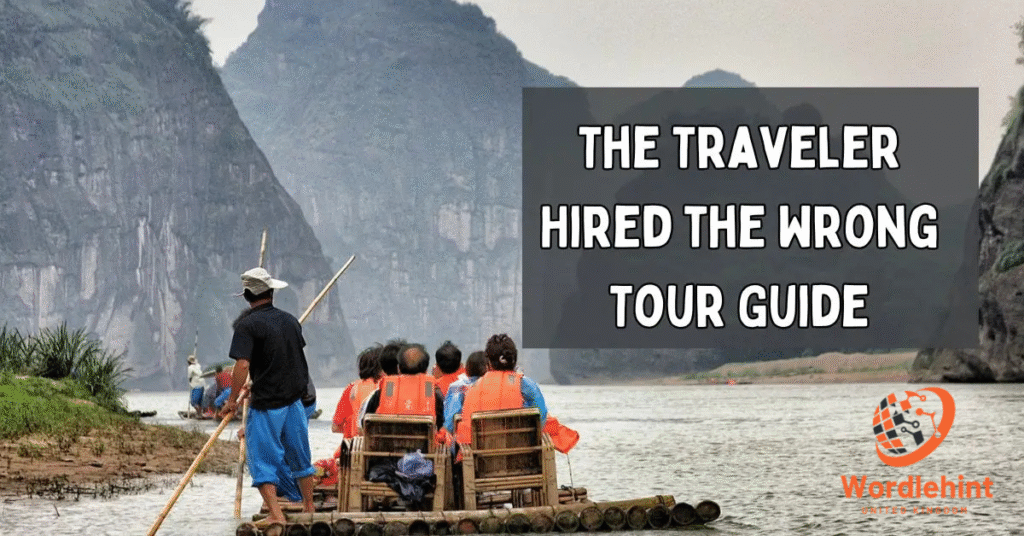
Planning a dream trip gone wrong: Jake booked a trip to Morocco through a third-party travel website. His guide claimed to be a local expert, but red flags quickly emerged.
Early red flags and ignored instincts: The guide arrived late, had limited knowledge of historical sites, and spoke broken English despite promises of fluency.
Safety scares and wasted money: Jake was taken to questionable neighborhoods and charged extra for “special access” to places that were actually free to enter.
Emotional impact of a bad guide: Jake returned home disappointed and stressed. What was supposed to be a cultural adventure became a frustrating ordeal.
Financial and Safety Consequences
Hidden Fees and Poor Budgeting
Bad guides often suggest overpriced shops or demand unexpected tips. This disrupts your budget and adds stress.
Unsafe Areas and Missed Experiences
You may be taken to unsafe neighborhoods or miss iconic sites simply because the guide didn’t plan well or wanted to cut corners.
Lost Time at Tourist Traps
Instead of exploring authentic attractions, you might spend hours at commercialized spots where the guide earns a commission.
Trust Issues and Emotional Burnout
Repeated disappointments drain your enthusiasm. Feeling unsafe or cheated leaves a lasting emotional toll.
What to Do If You’ve Hired the Wrong Tour Guide
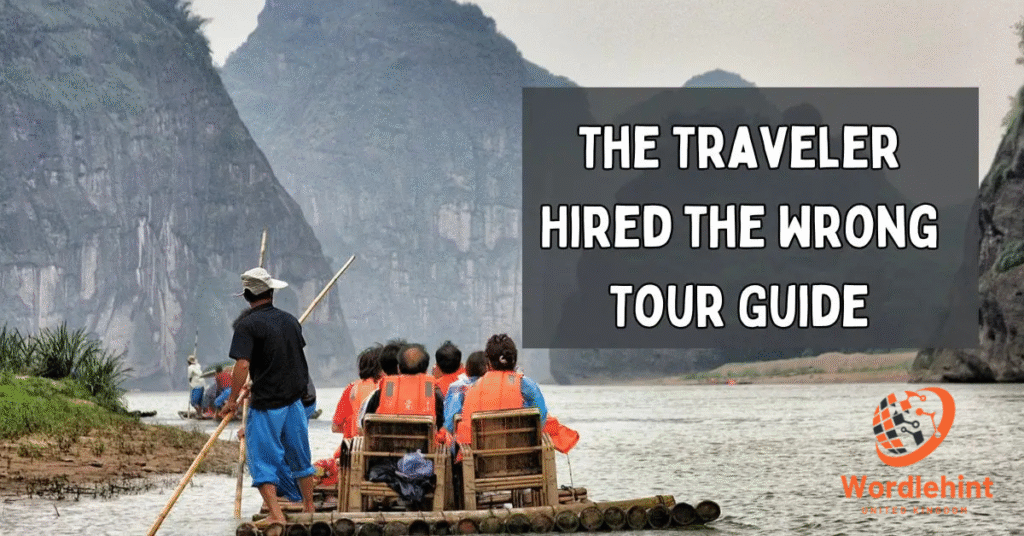
Speak Up – How to Address Concerns Politely
Voice your concerns calmly but clearly. Example: “I noticed we’re not following the itinerary. Could we please stick to the original plan?”
When and How to Request a Refund or Change
If the service is unacceptable, don’t hesitate to ask for a partial refund or a different guide. Use booking platforms for dispute resolution if necessary.
Safety First – Know When to Leave
If you feel unsafe, remove yourself from the situation. Return to your hotel or contact local authorities if needed.
Document Everything Photos, Notes, Recordings
Keep a record of interactions, places visited, and issues encountered. This is useful for complaints or refund requests.
Turn to Your Hotel or Booking Platform for Help
Hotels often have trusted local contacts. If you booked through an agency, notify them immediately and request support.
How to Research and Vet Tour Guides Properly
Read Reviews What to Look For
Look for consistent positive reviews on trusted platforms like TripAdvisor or Viator. Watch out for repetitive language in fake reviews.
Verify Credentials and Licenses
Ask for a copy of their license or guide ID. Many countries require tour guides to be certified.
Ask Pre-Booking Interview Questions
Questions like “What are your favorite hidden spots here?” or “Can I see a sample itinerary?” help gauge knowledge and attitude.
Use Trusted Platforms and Local Tourism Boards
Book through reputable sites or ask local tourism boards for certified guides.
Red Flags You Should Never Ignore
Low prices, no website or portfolio, vague answers, and pressure to book fast are warning signs.
Smart Tools to Help You Stay in Control While Traveling
Use eSIMs for Europe (Unlimited Max & Lite Plans)
Stay connected without roaming charges. eSIMs offer instant data access to search reviews, maps, and contact support.
Travel Apps for Self-Guided Tours
Apps like Rick Steves Audio Europe, GPSmyCity, and Google Maps offer offline tours and local tips.
Emergency Contact & Translation Apps
Keep apps like Google Translate and local emergency numbers handy for tough situations.
Lessons Learned – How to Turn a Bad Trip into a Positive One
Build Resilience and Flexibility
Bad experiences can teach you to adapt and think on your feet skills every traveler needs.
Learn to Trust Your Instincts
If something feels off, it probably is. Listen to your gut before committing.
Share Your Experience to Help Others
Post honest reviews and share your story to protect future travelers.
Leave Constructive Reviews (with Examples)
Explain what went wrong and how it could be improved. Keep it factual and respectful.
How to Find the Right Tour Guide Next Time
- Use trusted local agencies or referrals
- Ask specific questions before booking
- Compare multiple options
- Book in advance during peak season
- Always have a Plan B
FAQs
What are the signs I’ve hired the wrong tour guide?
Poor knowledge, bad communication, unprofessional behavior, and frequent itinerary changes.
Can I ask for a refund if the guide was bad?
Yes, especially if you booked through a platform or agency. Document your issues.
How do I check if a guide is licensed?
Ask to see their certification or check with local tourism boards.
What’s the safest way to book a guide?
Through verified agencies, apps, or hotel referrals.
Should I avoid cheap tours?
Not always, but if a deal seems too good to be true, research thoroughly.
How can I safely leave a tour I’m unhappy with?
Stay calm, communicate, and remove yourself safely. Alert your hotel or local support.
What tools help in a self-guided tour?
Audio guide apps, offline maps, and travel blogs.
What rights do I have as a traveler?
You can file complaints, request refunds, and contact local tourism authorities.
How can I write a helpful review after a bad guide?
Focus on facts. Mention what went wrong and how it impacted your experience.
Is it okay to travel without a guide?
Yes! Many travelers enjoy self-guided experiences using modern tools and apps.
Conclusion
A great guide adds depth, safety, and joy to your journey. With proper research and preparation, you can ensure your travel memories are positive.
A better trip begins with better prep.
Blog
Best Thailand Family Holiday Guide 2025 for First-Time Travelers

Why Thailand is the Best Family-Friendly Destination
Thailand captivates families with its vibrant mix of culture, adventure, and affordability. From bustling Bangkok to serene beaches, it offers something for every age. Friendly locals and safe, kid-friendly attractions make it welcoming for first-timers.
Explore ancient temples, lush jungles, or relaxing shores. Affordable accommodations and food suit tight budgets, while diverse activities keep everyone entertained.
Whether it’s elephant encounters or waterpark thrills, Thailand family holidays ensures fun for kids and relaxation for parents.The country’s infrastructure supports family travel, with English widely spoken in tourist areas.
Clean public transport and family-oriented tours simplify exploration. Thailand’s warm hospitality and endless discoveries create unforgettable memories.
Planning Your Thailand Trip: A Step-by-Step Guide
Organizing a family trip to Thailand requires simple steps to ensure a smooth adventure. Start early to secure deals and prepare for a hassle-free experience.
Essential Travel Documents
Check that all family passports are valid for six months beyond your travel dates. Depending on your country, Thailand offers visa-free entry or visas on arrival for many nationalities. Research requirements early and carry printed copies of bookings and IDs.
Vaccinations and Health Tips
Consult your doctor 4–6 weeks before departure for vaccinations like Hepatitis A, Typhoid, and routine shots (MMR, DTP). Pack a small first-aid kit with kids’ medications. Use bottled water and hand sanitizers to stay healthy.
What to Pack for Kids and Parents
Pack lightweight clothing, sunscreen, and mosquito repellent for Thailand’s tropical climate. Include kids’ favorite snacks, travel games, and coloring books for long journeys. Don’t forget swimwear and hats for beach days.

Planning Your Thailand Trip
Thailand at a Glance: Must-Know Facts
Thailand Family Holidays offers families a vibrant, accessible destination. Knowing key details helps you navigate with ease and enjoy your trip fully.
- Capital: Bangkok
- Currency: Thai Baht (THB)
- Language: Thai (English common in tourist spots)
- Time Zone: GMT+7
- Emergency Number: 1155 (Tourist Police)
These facts ensure you’re prepared for communication, payments, and emergencies. Thailand’s tourist-friendly environment makes it easy to connect with locals and explore confidently.

Best Time to Visit Thailand With Kids
Choosing the right time for your Thailand family trip maximizes fun and comfort. Each season offers unique experiences tailored to different preferences.
Cool, Dry Season (Nov–Feb)
This season’s mild weather (20–30°C) is perfect for families. Beaches shine, and festivals like Loy Krathong captivate kids. Book early as it’s peak season with higher prices and crowds.
Hot Season (Mar–May)
Temperatures soar (30–40°C), so plan early morning or evening outings. Stay hydrated and visit indoor attractions like museums or malls. Fewer crowds mean better deals on accommodations.
Rainy Season (Jun–Oct)
Short showers don’t dampen fun. Lower costs and quieter attractions make this ideal for budget travelers. Indoor activities like cooking classes or aquariums keep kids engaged.
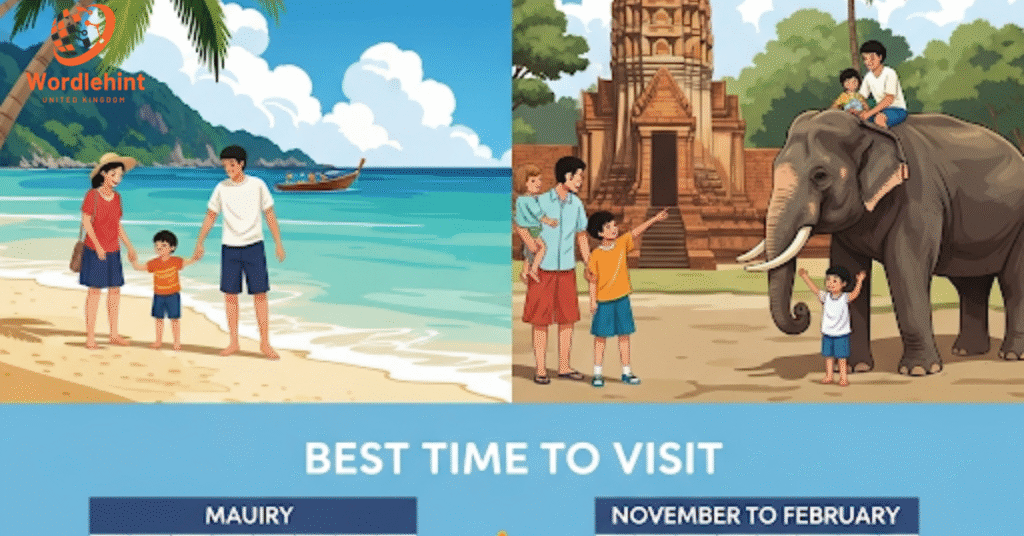
Family Safety Tips While in Thailand
Safety ensures a worry-free Thailand adventure. Simple precautions keep your family secure while enjoying the country’s charm.
Stick to freshly cooked food and bottled water to avoid tummy troubles. Pack familiar snacks for picky eaters. Comprehensive travel insurance covers unexpected medical or trip issues.
Always supervise kids in crowded markets or tourist spots. Thailand’s locals are warm, but stay vigilant. The Tourist Police (1155) are reliable for emergencies and speak English.
Teach kids basic safety rules, like staying close in busy areas. Carry a hotel card with contact details in case anyone gets lost. These steps ensure a stress-free trip.
How to Travel Thailand With Kids: Flights & Transport
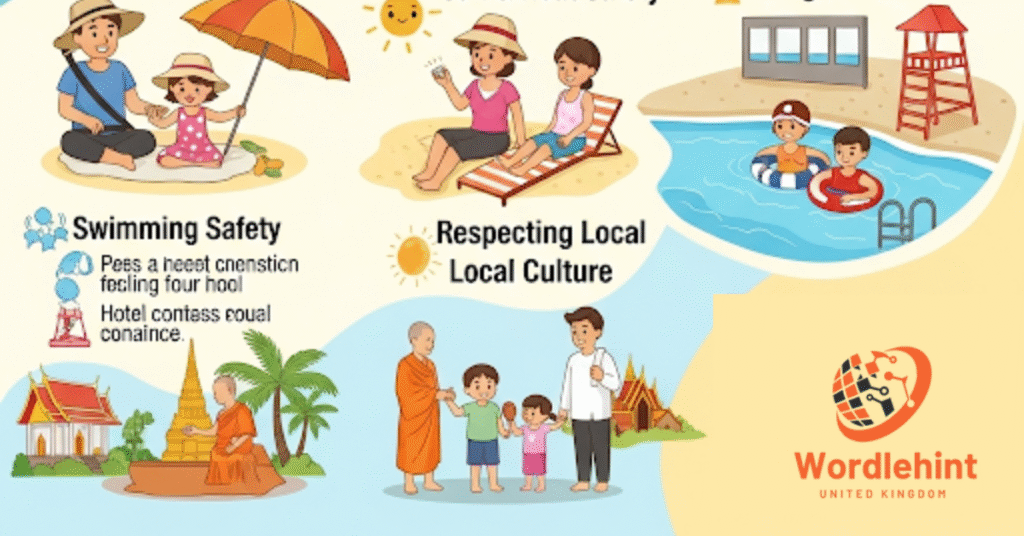
Getting to and around Thailand is straightforward with family-friendly options. Plan transport to keep kids comfortable and stress low.
Booking Flights from Major Countries
Book flights 3–4 months in advance for deals from the US, UK, or Australia. Major airlines like Thai Airways or Emirates offer direct routes to Bangkok. Look for family discounts or extra baggage allowances.
Airport Arrival Tips
Suvarnabhumi Airport (BKK) is modern and family-friendly. Use priority family lanes at immigration and have documents ready. Stick to official taxi counters or pre-booked transfers for safety.
Bangkok Airport Transfers
Choose metered taxis, Grab rides, or airport shuttles for easy transfers. Pre-arrange private vans for larger families. All options are safe and affordable, ensuring a smooth start.
Budgeting & Money Tips for Families
Managing money in Thailand is simple with a bit of planning. Families can stretch their budget while enjoying all the country offer.
Local Currency & Exchange
The Thai Baht (THB) is king. Exchange small amounts at airports, then use local banks or authorized counters for better rates. Carry cash for markets and small vendors.
Using ATMs & Cards
ATMs are plentiful in cities and tourist areas. Use cards with no foreign transaction fees for convenience. Inform your bank of travel plans to avoid card blocks.
Getting Around Thailand with Children
Thailand’s transport options suit families, balancing adventure and comfort. Choose based on your itinerary and kids’ needs.
Trains offer scenic, budget-friendly travel, ideal for older kids who enjoy the journey. Tuk-tuks provide fun, short rides—always negotiate fares first. Bangkok’s BTS Skytrain is fast, clean, and great for city exploration with kids.
Private vans or hired cars are perfect for families, offering flexibility and space. Book through reputable agencies for safety. These options make navigating Thailand’s cities and islands a breeze.
Best Places to Visit in Thailand with Family
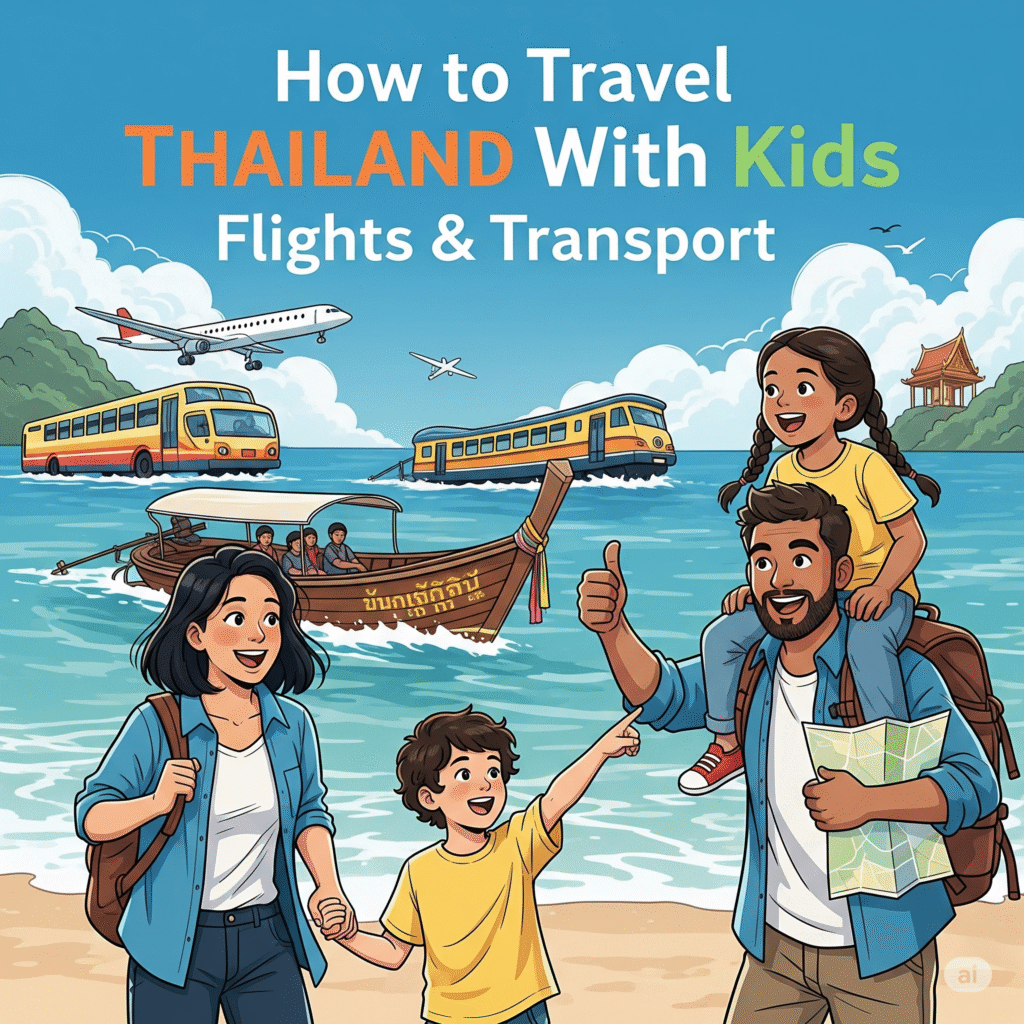
Thailand’s diverse destinations cater to kids and parents alike. These spots blend fun, culture, and relaxation for all ages.
Bangkok: Culture Meets Entertainment
Explore the Grand Palace, kid-friendly Sea Life Aquarium, or Lumpini Park. River cruises offer scenic, relaxing sightseeing. Malls like Siam Paragon have play zones and food courts.
Chiang Mai: Nature & Adventure
Visit ethical elephant sanctuaries, try zip-lining, or shop at night markets. Cooking classes engage kids, while temples offer cultural insights. Chiang Mai’s cool vibe suits families.
Phuket: Beach Bliss & Waterparks
Phuket’s Patong Beach and waterparks like Splash Jungle thrill kids. Family resorts offer pools and activities. Teens love water sports, while toddlers enjoy safe shores.
Koh Samui: All-in-One Island
Koh Samui boasts family resorts, nature trails, and calm beaches. Visit waterfall hikes or enjoy beachside dining. It’s easy to navigate and perfect for all ages.
Koh Lanta: Slow Travel & Tranquility
Koh Lanta’s quiet beaches and low-key vibe suit families seeking calm. Snorkeling and small resorts keep everyone happy. It’s less crowded than other islands.
Khao Sok National Park: Jungle Adventures
Stay in unique treehouses and enjoy canoe tours or guided jungle safaris. Khao Sok’s wildlife and scenery captivate kids and parents seeking nature-filled adventures.
Shopping With Kids in Thailand
Shopping in Thailand is a family adventure. Bangkok’s malls, like MBK, offer kid zones, arcades, and global food chains for easy meals. Night markets in Chiang Mai or Phuket sell souvenirs, toys, and local snacks kids love. Bargain politely and stick to marked stalls to avoid scams. These vibrant spots blend fun and culture, keeping everyone entertained.
How to Interact with Locals: Thai Etiquette for Families
Respecting Thai customs strengthens connections. Teach kids the “wai” greeting a slight bow with palms together to show respect. Dress modestly at temples, covering shoulders and knees. Always smile and stay polite, even in busy markets. Avoid overly pushy vendors and stick to reputable stalls for safe purchases. These habits ensure warm interactions.
Language Tips: Basic Thai Phrases to Know
Learning a few Thai phrases delights locals and helps navigation. Say “Sawasdee” for hello, “Khob Khun” for thank you, and “Chai/Mai” for yes/no. In emergencies, use “Chuay Duay!” for help. Practice these with kids for fun and confidence while exploring Thailand.
FAQs
Is Thailand safe for family travel?
Yes, Thailand is safe with precautions. Stick to tourist areas, supervise kids, and use bottled water. Tourist Police (1155) assist foreigners.
What are the best family resorts in Thailand?
Top picks include Centara in Phuket, Anantara in Koh Samui, and Four Seasons in Chiang Mai for kid-friendly amenities.
When is the cheapest time to visit Thailand?
The rainy season (Jun–Oct) offers lower prices on flights and hotels, with fewer crowds.
Are Thai street foods safe for kids?
Freshly cooked street food from busy stalls is generally safe. Avoid raw items and ensure kids eat familiar snacks if needed.
Do I need a visa for Thailand with kids?
Many nationalities get visa-free entry or visas on arrival. Check requirements based on your country.
What’s the best island in Thailand Family holidays?
Koh Samui and Phuket offer family resorts, safe beaches, and activities for all ages.
How do I keep kids entertained on long flights to Thailand?
Pack games, tablets with movies, snacks, and comfort items like blankets or stuffed toys.
Can I drink tap water in Thailand?
No, stick to bottled water to avoid health issues, especially for kids.
How much money do I need for a 7-day family trip to Thailand?
Budget $1,000–$2,000 for a family of four, depending on accommodation and activities.
What are emergency numbers for tourists in Thailand?
Call 1155 for Tourist Police or 1669 for medical emergencies.
Conclusion
Thailand Family Holidays welcomes families with affordable adventures, rich culture, and stunning nature. From Bangkok’s vibrant streets to Koh Samui’s tranquil beaches, it’s a perfect first-time international destination.
With proper planning passports, vaccinations, and smart packing your trip will be seamless. Embrace Thai hospitality, try local foods cautiously, and explore with confidence. This guide equips you for a memorable Thailand family holidays filled with joy and discovery.
Blog
1. Introduction to Bowling Ball Beach, California
-

 Blog4 weeks ago
Blog4 weeks agoKing Charles Sustainable Travel Initiatives A Green Royal Vision
-

 Blog3 months ago
Blog3 months agoLuxury Villas in Italy Le Collectionist Live the Italian Dream
-

 Blog2 months ago
Blog2 months agoLuxury Villas Greece Le Collectionist – Inside Their Exclusive Collection (2025)
-

 Blog3 months ago
Blog3 months agoWho Was Anna Zauner from Simi Valley?
-

 Blog1 month ago
Blog1 month agoLuxury Villas Provence Le Collectionist – Ultimate Guide 2025
-

 Blog2 months ago
Blog2 months agoSelena Green Vargas Biography, Fame & Disappearance
-

 Blog1 month ago
Blog1 month agoLuxury Villas Ibiza Le Collectionist Top Private Retreats for 2025
-

 Blog7 days ago
Blog7 days agoHow Old Is America? A Complete Guide to Its Real Age & History



